Siアバランシェフォトディテクター、自由空間型
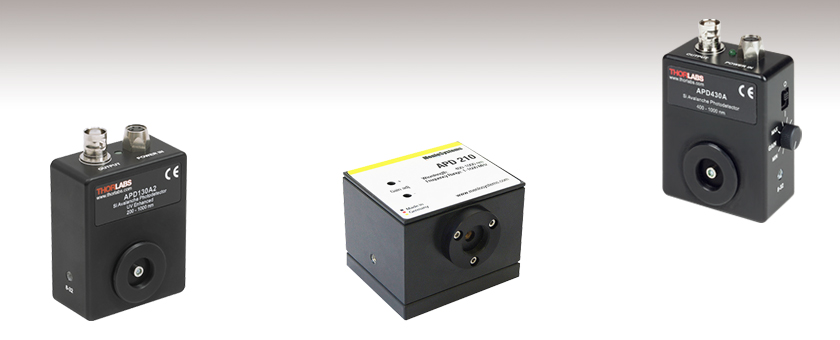
- High-Speed Response Up to 1 GHz
- Conversion Gains up to 2.65 × 109 V/W
- Wavelength Range of 200 - 1000 nm or 400 - 1000 nm
- Temperature-Compensated and Variable-Gain Versions Available
APD210
High-Speed APD
APD130A2
Temperature-Compensated APD
APD430A
Variable-Gain,
Temperature-Compensated APD

Please Wait
| Free-Space Si APD Selection Guide | |||
|---|---|---|---|
| Item # | Wavelength Range | Bandwidth (3 dB) | Type (Quick Links) |
| APD130A2(/M) | 200 - 1000 nm | DC - 50 MHz | Temperature Compensated |
| APD130A(/M) | 400 - 1000 nm | ||
| APD440A2 | 200 - 1000 nm | DC - 0.1 MHz | Variable Gain, Temperature Compensated |
| APD410A2(/M) | DC - 10 MHz | ||
| APD430A2(/M) | DC - 400 MHz | ||
| APD440A | 400 - 1000 nm | DC - 0.1 MHz | |
| APD410A(/M) | DC - 10 MHz | ||
| APD430A(/M) | DC - 400 MHz | ||
| APD410 | 200 - 1000 nm | 5 - 900 MHz | Variable Gain, Temperature Compensated, High Speed |
| APD210 | 400 - 1000 nm | 5 - 1000 MHz | |
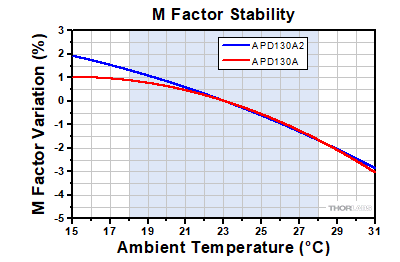
Click to Enlarge
Figure 1.1 では、温度補償型アバランシェフォトディテクタと、当社の標準的なディテクタの増倍係数(M factor)の温度依存性について比較しています。青い網掛け部分は、M Factorの安定性が±3%以内に保証される温度範囲を示しています。
特長
- 2.5 fW/√Hzの低いノイズ等価出力(NEP)
- 3 dBにおける帯域幅:最大1 GHz
- 18~28 °Cにおける増倍率(M factor)の安定性が≤±3%となる温度補償機能付きモデルもご用意
- 可変利得機能付きディテクタもご用意(M factor:5~50または10~100)
- 自由空間光入射部にはレンズチューブ取付け用のSM05内ネジとSM1外ネジ付き
- AC電源アダプタが付属
自由空間光用Siアバランシェフォトディテクタ(APD)は、標準的なPINディテクタと比べ、感度が高く、低ノイズの性能をご提供します。このAPDは、微弱光レベルの用途に適しています。また、標準のAPDに加え、可変利得機能付き(M factor)、および温度補償機能付きのAPDもご用意しています。
一般的に、アバランシェフォトディテクタは内部利得機構を利用して感度を増大させます。高い逆バイアス電圧をダイオードに印加し、強い電界を発生させます。 そして、入射光子によって電子-正孔対が生じると、この電界により電子が加速し、衝突電離によって2次電子が発生します。その結果、電子なだれの状態となり、利得係数は数百倍になります。これは逆バイアス電圧と温度の係数である増倍率(M)で表されます。一般的に、増倍率は低温になると増大し、高温になると減少します。同じ様に、逆バイアス電圧を上げると増倍率は上昇し、逆バイアス電圧を下げると低下します。
温度補償機能付きのAPD130A2/M およびAPD130A/Mでは、内蔵されているサーミスタの検出値とバイアス電圧が相殺され、温度変化が増倍率に与える影響を低減します。 温度補償型ではないAPDとの比較については、Figure 1.1をご参照ください。
可変利得機能付きAPD400シリーズディテクタでは、温度補償機能に加え、筐体側面の回転ノブを使用してダイオードの逆バイアス電圧の調整が可能で、これによって増倍率(M)を5~50、または10~100に変化させることができます。
当社では、900 MHzまたは1 GHz(@3 dB)まで高速応答する高感度アバランシェフォトディテクタAPD410およびAPD210もご用意しています。また、当社のSiフォトダイオードおよびディテクタの応答の一様性を向上させるよう設計されたスペクトル特性平坦化フィルタもご提供しています。詳細はこちらをご参照ください。
当社のすべてのアバランシェフォトディテクタのラインナップは「セレクションガイド」タブでご覧いただけます。なお、当社のシングルフォトンディテクタは、唯一単一光子のカウントに適したアバランシェフォトディディテクタです。
| Avalanche Photodiode Selection Guidea |
|---|
| Free-Space Si APDs |
| Fiber-Coupled Si APDs |
| Free-Space InGaAs APDs |
| Fiber-Coupled InGaAs APDs |
下記の各フォトディテクタ(黄色いボックス部)をクリックすると仕様がご覧いただけます。
温度補償型Siアバランシェフォトディクタ
すべての技術データは、温度23±5°C、相対湿度45±15%(結露なし)の条件下で有効です。
| Item # | APD130A2(/M) | APD130A(/M) |
|---|---|---|
| Detector Type | UV Enhanced Silicon APD | Silicon APD |
| Wavelength Range | 200 - 1000 nm | 400 - 1000 nm |
| Output Bandwidth (3 dB) | DC - 50 MHz | |
| Active Area Diameter | 1 mm | |
| Typical Max Responsivity | 25 A/W @ 600 nm (M = 50) | 25 A/W @ 800 nm (M = 50) |
| M Factora,b | 50 | |
| M Factor Temperature Stabilityc | ±2% (Typical); ±3% (Max) | ±2% (Typical); ±3% (Max) |
| Transimpedance Gain | 50 kV/A with 50 Ω Terminationd 100 kV/A for High-Impedance Termination | |
| Max Conversion Gaine,f | 2.5 x 106 V/W | |
| CW Saturation Power | 1.5 µW | |
| Max Input Powerg | 1 mW | |
| Minimum NEP (DC - 50 MHz)e,h | 0.21 pW/√Hz | 0.20 pW/√Hz |
| Integrated Noise (DC - 50 MHz) | 1.4 nW (RMS) | 1.5 nW (RMS) |
| Electrical Outputs | 50 Ω BNC | |
| Max Output Voltage | 1.8 V with 50 Ω Termination 3.6 V with High-Impedance Termination | |
| DC Offset Electrical Output | < ±15 mV | |
| Power Supplyi | ±12 V @ 250 mA (100/120/230 VAC, 50 - 60 Hz, Switchable) | |
| General | ||
| Operating Temperature Range | 0 to 40 °C (Non-Condensing) | |
| Storage Temperature Range | -40 to 70 °C | |
| Device Dimensions (H x W x D) | 75.5 mm x 50.8 mm x 27.4 mm (2.97" x 2.00" x 1.08") | |
| Weight | < 0.1 kg | |
可変利得・温度補償型Siアバランシェフォトディテクタ
すべての技術データは、温度23±5°C、相対湿度45±15%(結露なし)の条件下で有効です。
可変利得・温度補償型高速アバランシェフォトディテクタ
| Item # | APD410 | APD210 |
|---|---|---|
| Detector Type | Si APD | |
| Optical Input | Free Spacea | |
| Wavelength Range | 200 - 1000 nm | 400 - 1000 nm |
| Damage Threshold | 10 mW | 10 mW |
| Active Area Diameter | 0.2 mm | 0.5 mm |
| Frequency Range | 1 MHz - 1600 MHz | |
| 3 dB Bandwidth | 5 MHz - 900 MHz | 5 MHz - 1000 MHz |
| Rise Time | 500 ps | 500 ps |
| Conversion Gain (Max)b | 4.5 x 104 V/W @ 650 nm | 2.5 x 105 V/W @ 800 nm |
| NEP (Calculated)c | 87.6 pW/√Hz | 0.24 pW/√Hz |
| Dark State Noise Leveld | -80 dBm | |
| M Factor | 50 | 100 |
| Typical Max Responsivity | 22 A/W @ 650 nm | 50 A/W @ 800 nm |
| Output Impedance | 50 Ω | |
| Output Connector | BNC | |
| Output Coupling | AC | |
| Current Consumption (Max) | 200 mA | |
| Supply Voltagee | +12 to +15 V | |
| Operating Temperature | 10 to 40 °C | |
| Storage Temperature | -20 to +85 °C | |
| Storage Humidity | 10% - 90% RH | |
| Device Dimensions | 60 mm x 50 mm x 47.5 mm (2.36" x 1.97" x 1.87") | |
BNCメス型出力端子(フォトディテクタ)
APDオス型(パワーケーブル)
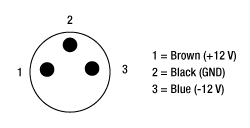
APDメス型(フォトディテクタ)
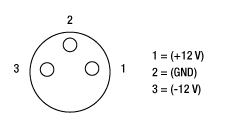
| Components for Fiber Couplinga | |
|---|---|
| Item # | Description |
| - | Free-Space Avalanche Photodetector |
| LM1XY(/M) | Translating Lens Mount for Ø1" Optics |
| SM1L10 | SM1 (1.035"-40) Lens Tube, 1" Long |
| - | Fiber Collimator (Dependent on Fiber) |
| AD11F or AD12F | SM1-Threaded Adapters for Ø11 or Ø12 mm Fiber Collimators (Dependent on Collimator) |
| - | Mounted Molded Aspheric Lens (Dependent on Collimator) |
| S1TM06, S1TM08, S1TM09, S1TM10, or S1TM12 | SM1-Threaded Adapter for Molded Aspheric Lens Cell (Dependent on Lens) |
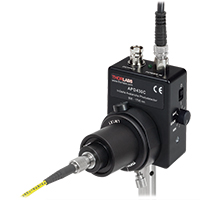
Click to Enlarge
Figure 4.1 ファイバからの出射光は、信号光をディテクタの受光面に集光するために、非球面レンズを用いてフォトディテクタに結合されています。
自由空間光用アバランシェフォトディテクタにファイバからの出射光を結合する方法
当社の標準的なオプトメカニクスを用いて、ファイバからの出射光を自由空間光用アバランシェフォトディテクタに結合することができます。ファイバ結合においては、ファイバ先端からの出射光の発散を考慮して、全ての信号光をディテクタの受光面に集光することをお勧めします。受光面がØ1 mmより小さいディテクタに対して標準的なファイバーコネクタ用アダプタを使用すると、結合損失が大きくなり、周波数応答特性が低下する場合があります。
高い結合効率を得るには、Figure 4.1のようにファイバーコリメーションパッケージ、集光レンズおよびXY移動マウントを使用する必要があります。写真のアバランシェフォトディテクタでは、ファイバーコリメータ、レンズチューブコリメータアダプタ、レンズチューブ、XY移動マウントが取り付けられています。レンズチューブ内のアダプタで保持されている非球面レンズ(写真では見えません)で、コリメート光がディテクタの受光面に集光されています。また、XY移動マウントで中心合わせができます。
当社ではファイバ結合型SiフォトディテクタAPD431Cもご用意しています。これにはM12 x 0.5ネジ付きフランジが付いており、M12 x 0.5ネジ付きファイバーコネクタアダプタを直接取付けることができます。このコンパクトで堅固な仕組みにより、ファイバ結合を高い再現性で簡単に行うことができます。 M12 x 0.5ネジ付きフランジは、当社のすべてのアバランシェフォトディテクタに追加することができ、それによって堅固なファイバ結合を実現できます。詳細は当社までお問い合わせください。
パルスレーザ:パワーとエネルギーの計算
パルスレーザからの放射光が、使用するデバイスや用途に適合するかどうかを判断する上で、レーザの製造元から提供されていないパラメータを参照しなければならない場合があります。このような場合、一般には入手可能な情報から必要なパラメータを算出することが可能です。次のような場合を含めて、必要な結果を得るには、ピークパルスパワー、平均パワー、パルスエネルギ、その他の関連するパラメータを必要とすることがあります。
- 生物試料を損傷させないように保護する
- フォトディテクタなどのセンサにダメージを与えることなくパルスレーザ光を測定する
- 物質内で蛍光や非線形効果を得るために励起を行う
パルスレーザ光のパラメータはFigure 170AおよびTable 170Bに示します。参照用として、計算式の一覧を以下に示します。資料を ダウンロードしていただくと、これらの計算式のほかに、パルスレーザ光の概要、異なるパラメータ間の関係性、および計算式の適用例がご覧いただけます。
計算式 | ||||
 | 、 |  | ||
 | ||||
 | ||||
 | ||||
平均パワーから算出するピークパワー、ピークパワーから算出する平均パワー : | ||||
 | 、 |  | ||
| 平均パワーおよびデューティーサイクルから算出するピークパワー*: | ||||
 | *デューティーサイクル( ) はレーザのパルス光が放射されている時間の割合です。 ) はレーザのパルス光が放射されている時間の割合です。 | |||
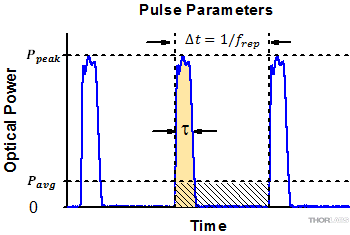
Click to Enlarge
Figure 170A パルスレーザ光の特性を記述するためのパラメータを、上のグラフとTable 170Bに示します。パルスエネルギ (E)は、パルス曲線の下側の黄色の領域の面積に対応します。このパルスエネルギは斜線で表された領域の面積とも一致します。
| Table 170B パルスのパラメータ | |||||
|---|---|---|---|---|---|
| パラメータ | シンボル | 単位 | 説明 | ||
| パルスエネルギ | E | ジュール[J] | レーザの1周期中に放射される1パルスの全放射エネルギ。 パルスエネルギはグラフの黄色の領域の面積に等しく、 これは斜線部分の面積とも一致します。 | ||
| 周期 | Δt | 秒 [s] | 1つのパルスの開始から次のパルスの開始までの時間 | ||
| 平均パワー | Pavg | ワット[W] | パルスとして放射されたエネルギが、1周期にわたって 均一に広がっていたと仮定したときの、 光パワーの大きさ(光パワー軸上の高さ) | ||
| 瞬時パワー | P | ワット[W] | 特定の時点における光パワー | ||
| ピークパワー | Ppeak | ワット [W] | レーザから出力される最大の瞬時パワー | ||
| パルス幅 |  | 秒 [s] | パルスの開始から終了までの時間。一般的にはパルス形状の 半値全幅(FWHM)を基準にしています。 パルス持続時間とも呼ばれます。 | ||
| 繰り返し周波数 | frep | ヘルツ [Hz] | パルス光が放射される頻度を周波数で表示した量。 周期とは逆数の関係です。 | ||
計算例
下記のパルスレーザ光を測定するのに、最大入力ピークパワーが75 mW
のディテクタを使用するのは安全かどうかを計算してみます。
- 平均パワー: 1 mW
- 繰り返し周波数: 85 MHz
- パルス幅: 10 fs
1パルスあたりのエネルギは、

と低いようですが、ピークパワーは、

となります。このピークパワーはディテクタの
最大入力ピークパワーよりも5桁ほど大きく、
従って、上記のパルスレーザ光を測定するのに
このディテクタを使用するのは安全ではありません。
| Posted Comments: | |
Amir Handemlan
(posted 2025-09-30 17:19:34.543) Hello,
In the "Fiber Coupling" Tab, how do you connect the FC/PC connector if the fiber (in the image) directly o the collimator?
It seems from the image that the aspheric lens is NOT fiber collinator... jjadvani
(posted 2025-10-01 03:30:38.0) Dear Amir, thank you for contacting Thorlabs. The collimator in the photo of the fiber coupling tab has a fiber connector that is inserted inside the AD11F. So, you attach the fiber directly to the fiber collimator. You may find a fiber linked collimator at this URL. Visit https://www.thorlabs.de/navigation.cfm?guide_id=2235 . I'll contact you directly to provide additional details. Dominik Schmidtlein
(posted 2025-05-14 09:02:46.073) Hello, when we change the gain of the APD410A2/M, we never see a linear increase in voltage, no matter how much light intensity we use. It always has an S-shape. At first, it almost doesn't rise, then it rises linearly, and at the maximum M-factor, the graph flattens out again. What is the cause of this? hkarpenko
(posted 2025-05-15 04:59:49.0) Dear Dominik,
thank you for your feedback. I will contact you directly to request some measurement data and discuss your application in detail with you. Kailin Sun
(posted 2025-03-14 12:14:16.087) During use, the dark noise became extremely loud, with 600 mV in the 1.8V detector range. hchow
(posted 2025-03-17 08:34:09.0) Dear Ms. Sun, I will have to clarify some details with you first. I will personally reach out to you. 1 1
(posted 2024-12-12 15:55:13.853) 您好,我们近日刚购置了你么的APD410AM,现在需要购置配套的支架,你们有吗。M4杆 hchow
(posted 2024-12-13 07:36:30.0) 你好,谢谢你的回复。您可以将我们的一个 M4 光学柱连接至 APD 的底面。 Gerald Auböck
(posted 2024-02-23 08:07:42.433) Hi,
do you by chance have data on the linearity of your
APD130A (except for the saturation power). Maybe dependent on gain setting.
Thanks, Gerald hkarpenko
(posted 2024-02-23 10:55:57.0) Dear Gerald,
thank you for your feedback.
These detectors are very linear up to the saturation power. I will have to check with our development team, whether we can share test data for these. I will contact you directly to discuss this topic further with you. Gerald Auböck
(posted 2024-02-23 08:06:49.84) Hi,
do you by chance have data on the linearity of your
APD130A (except for the saturation power). Maybe dependent on gain setting.
Thanks, Gerald dpossin
(posted 2024-02-27 04:12:21.0) Dear Gerald,
Thank you for your feedback. In general our photodiode based sensors provide a linearity of around 0.1% but the overall linearty will be limited by the temperature compensation which is in between 3 and 5%. Jay Lin
(posted 2023-11-29 11:29:44.647) These APD only need 12V bias to work? Isn't APD suppose to have a High Voltage supply? hkarpenko
(posted 2023-11-29 11:45:58.0) Dear Jay,
thank you very much for your feedback.
You are correct, that inside the APD there will built up a high bias voltage to induce the avalanche effect. However this high voltage is generated due to the circuitry of the APD and not needed to be generated externally by a high voltage power supply. user
(posted 2022-12-30 14:23:03.053) I have purchased lens assembly for fiber coupling for APD430A2.
The collimator F240FC-A and aspheric lens A280TM-A. I believe the one thread end of aspheric lens mount S1TM09 has to be mounted on the APD's thread and LM1XY on the other end of the thread. The lens tube can be mounted on the LMXY's other end. Further collimator mount on the other end of lens tube. Can you confirm the above placement of these lenses? The description in site says that aspheric lens is inside lens tube. Because S1TM09 is a thread to thread adapter, it cannot be inside the lens tube. fmortaheb
(posted 2023-01-02 08:14:12.0) Thank you very much for contacting Thorlabs. You can use the S1TM09 to mount the lens inside the lens tube. The SM1 thread on the S1TM09 is matching with the internal SM1 thread of the lens tube. I will contact you directly to discuss your application further. Eric Miller
(posted 2022-12-01 19:02:33.64) I'm using the UV-enhanced APD430A2. Do you have any advice on long-term UV operation with this APD close to the CW saturation limit? We've observed a 20x decrease in responsivity after several hundred hours operation at 250nm . Our tests on a unused replacement with a 8uW CW beam showed a decrease in responsivity of 0.5% per minute. Also can you clarify how the saturation power depends on wavelength at 250nm? We thought it should be higher than 8uW based on the lower responsivity at that wavelength. Thanks! hkarpenko
(posted 2022-12-02 09:10:13.0) Dear Eric,
thank you very much for your feedback.
Unfortunately we have not measured the degradation for this wavelength specifically. The saturation power can be estimated using the formula described in the manual on p.7.
I will reach out to you directly to discuss this case further. user
(posted 2022-10-24 14:21:26.803) I am an Indian user. I have bought APD 440A and 430A2 recently. European power cable is provided. Do you recommend using an UK to Indian adapter or an Indian power cable of same rating (250V , 16A) ? hchow
(posted 2022-10-25 06:04:46.0) Dear User, thank you for your enquiry.
I believe what you are looking for is "India type D to C13" power cord.
I will reach out to you privately for more information. hchow
(posted 2022-10-25 08:32:21.0) Thank you and have a nice day! user
(posted 2022-06-23 09:53:40.53) Hi, I am wondering about the time response (rise and fall time) of the APD430A and APD430A2 (400MHz bandwidth) models and the two Menlo APD410 and APD210 (1GHz) models.
I want to perform time resolved fluorescence with expected lifetimes of several nanosecond or longer.
What is the minimum decay time you can measure with those models? The APD410 and APD210 should have better rise/fall time, but the time response curves to fs pulse contain some ripples (see the menlo datasheet). What about the APD430A and _A2? Can you provide their response curve to ps or ns pulse?
Also, do you recommend those SiAPD or PMT for measuring fluorescence decay curves with nanosecond lifetimes? dpossin
(posted 2022-07-01 07:35:33.0) Dear Felice,
Thank you for your feedback. I reach out to you in order to provide information about that. user
(posted 2022-05-02 15:49:02.99) I am planning to buy APD440A and a fiber connector
adapter S120-FC2 which can connect to FC/PC 2mm narrow key end of a multimode fiber of core/clad as 200/220um. Is the power supply included with detector? Is there any other holding or mounting/screws options I need to buy with this?? I am doing a fiber-based experimental setup. Please suggest.
I am also planning to buy APD430A2 which has a smaller active area. Can you suggest a compatible fiber collimator, lens tube collimator adapter, lens tube, and X-Y translation mount ? wskopalik
(posted 2022-05-05 08:49:11.0) Thank you very much for your feedback!
I will contact you directly to provide assistance with the selection of the necessary components. yiming zang
(posted 2022-04-26 21:12:08.243) I want to know the sampling rate of the APD130A2/M.
Thanks! jjadvani
(posted 2025-02-03 06:27:29.0) Dear Yiming, thank you for your feedback. Unfortunately, there is no sampling rate spec for this APD130A2/M. We do have output bandwidth spec for this APD which is DC-50 MHz ( 3 dB). Jean Matias
(posted 2022-04-22 09:14:19.923) Hi,
I was wondering if you could send me the data for the APDs responsivity used to make the plots available here on the website.
Best,
Jean Matias mdiekmann
(posted 2022-04-25 06:30:05.0) Thank you for reaching out! We will contact you directly to share the requested data. Chen Kuo
(posted 2021-03-12 16:02:12.41) Dear manager,
Can you send me the relevant materials of APD120A/M? Because I am very interested in this equipment, I need to check the materials and experimental equipment that can be used for research.
Thank you. soswald
(posted 2021-03-18 04:02:49.0) Dear Chen Kuo,
thank you for your feedback. Unfortunately the exact parts list of the APD120A/M is proprietary information, but I have reached out to you directly to evaluate which information you need and what we can provide. Peter Meinhold
(posted 2020-12-22 00:31:31.11) We're using these APDs in our OEM instrument prototype, but we really want to be able to control the transimpedance gain electronically- is there any product that allows that, with similar NEP to the APD440A2? dpossin
(posted 2020-12-22 04:38:21.0) Dear Peter,
Thank you for your feedback. I am reaching out to your in oder to discuss opportunities. Thomas Price
(posted 2020-10-19 19:22:58.53) I'm using the APD410A detector and have a question on the noise floor. According to the spec sheet, the integrated noise is 130 pW based on the NEP from DC-10MHz. When I use the detector, I'm seeing a noise floor of 4.88 nW at rougly 20MHz. Do I need additional electrical filtering to attain the noise levels quoted in the specifications? MKiess
(posted 2020-10-22 06:42:55.0) Dear Thomas, thank you very much for your inquiry.
The listed NEP value is only valid for the specified frequency range. The measurement bandwidth must be less than or equal to that frequency range. If the measurement bandwidth exceeds that range,the NEP needs to be adjusted. However, this will increase the NEP significantly.
Furthermore the NEP value depends on the wavelength. The NEP value given in the Specs is the minimum NEP. Therefore the value has to be adjusted when using another wavelength. For more information on how NEP is calculated, please see Thorlabs' Noise Equivalent Power White Paper, which can be found using the follwoing link:
https://www.thorlabs.de/images/TabImages/Noise_Equivalent_Power_White_Paper.pdf
I have contacted you directly to discuss further details with you. Peter Meinhold
(posted 2020-10-05 01:40:22.59) Hi, I'm coupling light from a 105 micron, 0.1 NA fiber to an APD440A, currently with no additional optics. I have 3 questions: first do I need to add collimation, focusing and XY adjustment for such a combination? Second, if I do, is F950FC-A followed by C240TMD-A a reasonable pair to achieve good coupling to the detector? Third, does either answer change if the fiber is 105 micron 0.22 NA?
Thanks! MKiess
(posted 2020-10-08 09:29:13.0) Dear Peter, thank you very much for your inquiry. For fiber coupled applications I do not recommend the use of fiber connection adapters like the S120-FC, due to the small sensor area. This could cause high coupling losses and a degradation of the frequency response. To achieve high coupling efficiency, I recommend using a fiber collimation package, a focusing lens and an X-Y translator. I have contacted you directly to discuss further details. Yi Zheng
(posted 2020-04-04 18:04:01.96) Hi,
I am wondering what is the minimum power this PD can measure.
I want to measure CW power, should the minimum power be 0.21pW or 1.2nW according to the manual
Thanks.
Best, Yi nreusch
(posted 2020-04-06 10:32:34.0) This is a response from Nicola at Thorlabs. Dear Yi, thank you for your feedback. The specification you need to take into account is the bandwidth-dependent (BW) Noise Equivalent Power (NEP), which is 0.21 pW/(Hz)^0.5 for APD130A2/M and DC-50 MHz. This value allows you to calculate the minimum detectable power P_min = NEP (lambda) * (BW)^0.5. If you do not use an additional electrical filter to further decrease the NEP value, the minimum detectable power equals 1.48 nW.
Our photodiode tutorial and the dedicated white paper provides a more detailed explanation: https://www.thorlabs.com/newgrouppage9.cfm?objectgroup_id=9020. Mintae Chung
(posted 2019-11-24 13:11:06.53) Hello,
I have a question on the main difference between these APD Photodetectors and Silicon Photodiode (S121C). It's perhaps a silly question. But, It would be important to me. I've already got 'S121C' silicon photodiode type head just in case.
Best,
Mintae wskopalik
(posted 2019-11-26 03:52:16.0) This is a response from Wolfgang at Thorlabs. Thank you very much for your question!
The main difference between these APD photodetectors and the Si photodiode sensors (such as the S121C) is the way they are operated. In the APD photodetectors a high reverse bias voltage is applied to the diodes to create a strong electric field. When an incident photon generates an electron-hole pair, the electric field accelerates the electrons, leading to the production of secondary electrons by impact ionization. The resulting electron avalanche can produce a gain factor of several hundred times, which makes APD photodetectors sensitive for low power levels.
In the S121C sensor which is normally used with one of our power meters, the photodiode is operated without any bias and the current generated by incident light is measured directly. This makes it less sensitive, but also suitable for higher power levels.
It depends on the power levels and on the other requirements of your application which type of detector or sensor is more suitable. I will contact you directly to provide further assistance. User
(posted 2019-03-12 04:11:25.293) It seems that the quantum efficiency of your UV-enhanced Silicon APD at 300nm is 62% (computed with a Responsivity value of 0.15A/W, read on your responsivity graph). Could you explain this difference if we compare with your other Silicon detectors that show a quantum efficiency around 20% at 300nm? (As we expect from Silicon material at this wavelength)
Thank you for your answer. nreusch
(posted 2019-03-21 06:19:36.0) This is a response from Nicola at Thorlabs. Thank you for the inquiry. The APD430A2 and APD410A2 come with a UV enhanced photodiode. The material of such photodiodes differs from the composition of other Si photodiodes, which shifts the peak responsivity to lower values. Lint
(posted 2019-01-26 16:41:38.57) Hello, we are looking for this product APD120A for a customer project and we would like to enquire the price for this product in a MOQ of 50pcs, 100pcs, 200pcs and 300pcs.
Pls let us have the quote ASAP. Thank you. YLohia
(posted 2019-04-04 09:18:05.0) Hello, thank you for your interest in our products. For OEM inquiries, we can be reached at OEMSales@thorlabs.com. We have been in direct contact with you regarding this matter. minowa
(posted 2018-09-24 23:09:10.45) Hi, I'm wondering about the noise level of the APD210. On the manual and the web, the noise value 0.40 pW/√Hz is given as "NEP (calculated)" or "minimum NEP". I'd like to know the typical and maxmum NEP values, if possible. Furthermore, how did you calculate the NEP? Based on the Dark State Noise Level = -80dbm, a rough estimation of the NEP seems to be ~ sqrt(1mW*10^-8 * 50 ohm)/(2.5*10^5 V/W) /sqrt(1 GHz) ~ 2.8 fW/√hz. Am I missing some basic fact? nreusch
(posted 2018-09-28 10:47:13.0) This is a response from Nicola at Thorlabs. Thank you for your inquiry. The NEP for APD210 from Menlo Systems is calculated as follows:
NEP=I_rtot/(S*B^0.5) with I_rtot=(I_rin^2+I_tot^2)^0.5. In this calculation I_rin=1.2*10^-11 A is the noise current at the amplifier input caused by the amplifier chain. I_tot=6.95*10^-14 A is the noise current at the amplifier input caused by the diode. S is the responsivity of the diode, which is 50 A/W in this case and B is the bandwidth of the detector. The result is NEP=0.24 pW/Hz^0.5.
As the NEP is a function of responsivity, this value is valid for the peak responsivity value 50 A/W at 800 nm. I will contact you directly to discuss whether this detector is suitable for your application. r.ebrahimifard
(posted 2018-04-20 17:25:31.36) Dear Madam/Sir
What is the diiference between the sensitivity of APD and Single Photon Counters of thorlabs? Do Single Photon Counters use the same Si APD?
For a cytometry system, can I use APD instead of Single Photon Counters as APDs are also very sensitive? mvonsivers
(posted 2018-05-17 10:30:54.0) This is a response from Moritz at Thorlabs. Thank you for your inquiry. Our Single Photon Counter Modules are operated in Geiger Mode to have the ability to detect single photons. In contrast our Si APDs are operated below the breakdown voltage and are not suitable as single photon counters. I will contact you directly to further discuss your application. mccrady
(posted 2018-04-19 15:08:56.687) Are the power supplies for the APD120A2 UL listed? swick
(posted 2018-04-27 03:42:56.0) This is a response from Sebastian at Thorlabs. Thank you for the inquiry. Yes, the power supply LDS12B is UL and CE Compliant. iain.cowie
(posted 2018-03-12 12:13:25.913) Powersupply - can I run the ADP410A/M off a 12VDC battery? swick
(posted 2018-03-19 06:43:53.0) This is a response from Sebastian at Thorlabs. Thank you for the inquiry. It will not work to use a battery as power supply for our APD detectors. These detectors require three voltage levels: +12V , GND and -12V. shin
(posted 2017-07-27 18:11:18.41) Hi,
I am wondering about the rise and fall time of the APD130A2 model. I want to use it for measuring fluorescence (of weak intensity) decay curves in which a decay time is several nanosecond or longer. What is the minimum decay time you can gurantee with the model?
Second, could you recommend (highly sensitive) APD or PMT for measuring fluorescence decay curves with nanosecond lifetimes?
Thank you very much for your help.
Best,
Taeho swick
(posted 2017-07-28 03:12:39.0) This is a response from Sebastian at Thorlabs. Thank you for the inquiry. The rise/fall time of APD130A2 can be calculated from specified bandwidth. t_rise = 0.34/Bandwidth = 7ns
I have contacted you directly to provide further assistance. Benjamin.Stuhlmann
(posted 2016-12-09 14:00:49.267) Hello,
we use this APD as detector for a fluorescence experiment inside a vacuum chamber.
When we first contacted tech support it was unclear if the diode could withstand our vacuum conditions since this question was unpresedented at the time.
We tested it in our setup at pressures down to 10^-5 mbar for some months now and it is working just fine. By locating the detector as near at our molecular beam as possible, we improved our S/N ratio and simplified the adjustment of all components compared to the old experiment where the detector was outside the vacuum chamber.
If you are interested, I could send you some notes about our setup for further reference. swick
(posted 2016-12-12 03:11:46.0) This is a response from Sebastian at Thorlabs. Thank you very much for the feedback. We are always interested and appreciate that kind of information and feedback. I have contacted you directly. rajendhar.j2008
(posted 2016-09-28 18:12:37.377) We need the rising time of the detector swick
(posted 2016-09-29 05:27:54.0) This is a response from Sebastian at Thorlabs. Thank you very much for your inquiry.
The rise time of APD120A2/M can be calculated from specified bandwidth via: rise_time = 0.3497 / bandwidth
For APD120A2/M the rise time is 7ns. cmrogers
(posted 2016-02-09 18:56:07.087) How thick is the window on the detector for APD410A? shallwig
(posted 2016-02-10 08:38:00.0) This is a response from Stefan at Thorlabs. Thank you very much for your inquiry unfortunately we have no spec for the thickness of the detectors window. I will contact you directly to check if you have any further questions. moritz.wiesbauer
(posted 2014-05-08 14:39:01.4) Hello,
I purchased the APD120A/M recently and read in the manual the temperature dependancy of the APD. It says I should contact Thorlabs for further information about the decreasing M-factor with increasing temperature. How big is the decrease if the temperature is at 27°C or even up to 30°C?
I'm very thankful for any further information on this topic.
Best regards,
Moritz Wiesbauer
Institute of Applied Physics
Johannes Kepler Universität Linz
E-Mail: moritz.wiesbauer@jku.at shallwig
(posted 2014-05-12 09:32:36.0) This is a response from Stefan at Thorlabs. Thank you very much for your inquiry. I will send you a curve showing the temperature dependency of the M factor and would like to discuss your application in detail directly. |
アバランシェフォトディテクタのセレクションガイド
| Item # | Detector Type | Wavelength Range | 3 dB Bandwidth | Active Area Diameter | M Factor | Typical Max Responsivity | Max Conversion Gaina | Variable Gain | Temperature Compensated | Fiber-Coupledb |
|---|---|---|---|---|---|---|---|---|---|---|
| APD440A2 | UV Enhanced Silicon APD | 200 - 1000 nm | DC - 0.1 MHz | 1 mm | 5 - 50 | 25 A/W @ 600 nm (M = 50) | 1.25 x 109 V/W | - | ||
| APD410A2 | DC - 10 MHz | 0.5 mm | 5 - 50 | 25 A/W @ 600 nm (M = 50) | 12.5 x 106 V/W | - | ||||
| APD130A2 | DC - 50 MHz | 1 mm | 50 | 25 A/W @ 600 nm (M = 50) | 2.5 x 106 V/W | - | - | |||
| APD430A2 | DC - 400 MHz | 0.2 mm | 10 - 100 | 50 A/W @ 600 nm (M = 100) | 5.0 x 105 V/W | - | ||||
| APD410 | 5 - 900 MHzc | 0.2 mm | 50 | 22 A/W @ 650 nm (M = 50) | 4.5 x 104 V/Wd | - | ||||
| APD440A | Silicon APD | 400 - 1000 nm | DC - 0.1 MHz | 1 mm | 10 - 100 | 53 A/W @ 800 nm (M = 100) | 2.65 x 109 V/W | - | ||
| APD410A | DC - 10 MHz | 1.0 mm | 10 - 100 | 53 A/W @ 800 nm (M=100) | 26.5 x 106 V/W | - | ||||
| APD130A | DC - 50 MHz | 1 mm | 50 | 25 A/W @ 800 nm (M = 50) | 2.5 x 106 V/W | - | - | |||
| APD430A | DC - 400 MHz | 0.5 mm | 10 - 100 | 53 A/W @ 800 nm (M = 100) | 5.3 x 105 V/W | - | ||||
| APD431A | DC - 400 MHze | 0.5 mm | 10 - 100 | 53 A/W @ 800 nm (M = 100) | 5.3 x 105 V/W | |||||
| APD210 | 5 - 1000 MHzc | 0.5 mm | 100 | 50 A/W @ 800 nm (M = 100) | 2.5 x 105 V/Wf | - | ||||
| APD130C | InGaAs APD | 900 - 1700 nm | DC - 50 MHz | 0.2 mm | 10 | 9 A/W @ 1500 nm (M = 10) | 0.9 x 106 V/W | - | - | |
| APD410C | DC - 10 MHz | 0.2 mm | 4 - 20 | 18 A/W @ 1550 nm (M = 20) | 9.0 x 106 V/W | - | ||||
| APD430C | DC - 400 MHz | 0.2 mm | 4 - 20 | 18 A/W @ 1550 nm (M = 20) | 1.8 x 105 V/W | - | ||||
| APD431C | DC - 400 MHze | 0.2 mm | 4 - 20 | 18 A/W @ 1550 nm (M = 20) | 1.8 x 105 V/W | |||||
| APD450C | 1260 - 1620 nm | 0.3 - 1600 MHz | 1.5 mmg | 2 - 10 | 9 A/W @ 1550 nm (M = 10) | 45 × 103 V/W | - | |||
| APD310 | 850 - 1650 nm | 5 - 1000 MHzc | 0.04 mm | 30 | 0.9 A/W @ 1550 nm (M = 30) | 2.5 x 104 V/Wh | - |

- 温度補償により、18~28°Cにおける増倍係数(M Factor)の変動を±3%以下に抑制
- SM05内ネジとSM1外ネジによりファイバーアダプタやレンズチューブ、その他の部品の取り付けが可能
- AC電源アダプタが付属
自由空間光用アバランシェフォトディテクタAPD130A2/MならびにAPD130A/Mは、内蔵のサーミスタを用いてアバランシェフォトダイオードのバイアス電圧を補償することで、23 ± 5 ℃における増倍係数(M Factor)の変動を±3%以下に抑え、温度が変動する環境下においても優れた出力安定性を発揮します。
機械的マウントや電気的コネクタの取付け位置にも配慮し、またパッケージデザインもスリムなので、狭いスペースでもご使用いただけます。本体側面の3面にはM4取付け穴がそれぞれ1つずつ付いているので、複雑な機械的セットアップに簡単に組み込むことができます。また、SM05およびSM1シリーズのレンズチューブにも対応しています。SM1内ネジ付きのキャップが付属しています。
当社のSM1ネジ付きファイバーアダプタがこちらのディテクタに取り付け可能です。SM1内ネジ付きアダプタは直接筐体に取り付けられます(下記参照)。SM1外ネジ付きファイバーアダプタをディテクタの筐体に取り付けるにはSM1内ネジ付きレンズチューブが必要です。SM05外ネジ付きファイバーアダプタはこちらのディテクタに対応しません。

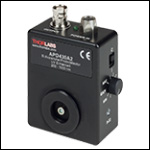
Click to Enlarge
Figure G2.1 増倍係数(M Factor)はAPD側面のノブで調整可能
- 連続可変利得
- 温度補償設計により、18~28°CにおいてM Factorの安定性が≤±3%に抑制
- SM05内ネジとSM1外ネジによりファイバーアダプタやレンズチューブ、その他の部品の取り付けが可能
- AC電源アダプタが付属
こちらの自由空間光用アバランシェフォトディクタには可変利得機能があり、本体右側にあるノブで調整できます。上記のディテクタAPD130A/Mと同様、内蔵のサーミスタによりアバランシェフォトダイオードのバイアス電圧が調整され、23 ± 5 °Cにおける増倍率(M Factor)の安定性を±3%以下に保ちます。ディテクタAPD430A2/MおよびAPD430A/Mの使用可能帯域幅はDC~400 MHzで、ほかの標準ならびに温度補償型APD製品より広くなっています。APD410A2/MおよびAPD410A/Mの使用可能帯域幅は若干狭くなっていますが(DC~10 MHz)、感度は高くなっています。APD440A2ならびにAPD440Aは、最大帯域幅が100 kHzと狭い帯域幅で高いトランスインピーダンスゲインを提供します。
機械的および電気的接続の方向を考慮した設計と小型のパッケージデザインにより、狭いスペースでもご使用いただけます。筐体の3面の縁部分にはM4取付け穴がそれぞれ1つずつ付いているので、複雑な機械的セットアップに簡単に組み込むことができます。また、SM05およびSM1シリーズのレンズチューブにも対応しています。SM1内ネジ付きのキャップが1個付属しています。
ファイバ結合の際の注意点:
当社の標準的なオプトメカニクスを用いて、ファイバからの出射光を自由空間光用アバランシェフォトディテクタに結合することができます。ファイバ結合の用途において、ディテクタAPD410A2/M、APD430A2/M、APD430A/Mのセンサ部分のサイズが小さいため、S120-FCなどのファイバーコネクタ用アダプタのご使用はお勧めいたしません。結合損失の増大や周波数応答の劣化につながる可能性があります。高い結合効率を得るには、ファイバーコリメーターパッケージならびに集光レンズならびにXY軸移動マウントをご使用ください。詳細は「ファイバーカップリング」のタブをご覧ください。
当社ではファイバ結合型SiフォトディテクタAPD431Cもご用意しています。これにはM12 x 0.5ネジ付きフランジが付いており、M12 x 0.5ネジ付きファイバーコネクタアダプタを直接取付けることができます。このコンパクトで堅固な仕組みにより、ファイバ結合を高い再現性で簡単に行うことができます。 M12 x 0.5ネジ付きフランジは、当社のすべてのアバランシェフォトディテクタに追加することができ、それによって堅固なファイバ結合を実現できます。詳細は当社までお問い合わせください。

用途例
- 高速パルスレーザ
- 超低光量信号
- 温度補償型アバランシェフォトディクタ
- RFアンプ内蔵
- 連続調整可能な利得設定
- 長期フィールド試験済み
- 自由空間入力、SM05内ネジ付き
- 使いやすいパッケージ
- 国内用の電源が付属
複数の連続光レーザまたはパルスレーザの間のビート信号検出用に開発されたSiアバランシェフォトディクタは、200~1000 nmまたは400~1000 nmの抵光量の入力信号で高い感度が必要な用途に適しています。APDシリーズのアバランシェフォトダイオードは、従来のPINフォトダイオードよりも高感度です。また高速性も持ち合わせており、例えばナノ秒オーダのパルスレーザの特性評価用にも使用できます。
このディテクタは、温度補償回路により、 10 °C~40 °C動作温度範囲で高利得安定性を維持します。温度補償回路は、降伏電圧付近の動作を確保するために約150 V DCバイアスを調整しています。
可視域(VIS)と、近赤外域(NIR)用のモデルをご用意しております。 これらのディテクタはコンパクトな設計なため、組み込み用途(OEM用途)向けにも適しています。
出力の弱いホモダインまたはヘトロダインのビートを信号を、高効率に検出および増幅しなければならない計測手法の研究などの用途に特にお勧めいたします。

- アバランシェフォトディテクタ(上記、型番APD210を除く)の交換用電源
- ±12 VDC出力
- 短絡回路を保護しオーバーロードを防ぐ電流リミット機能
- LED表示付きのOn/Offスイッチ
- AC入力電圧はスイッチ切り替え可能(100/120/230 VAC)
- 長さ2 mのケーブルはLUMBERG製オス型コネクタRSMV3付き
この±12 VDC安定化リニア電源LDS12Bは、型番APD210を除く上記のAPDシリーズのアバランシェフォトディテクタに付属する電源の交換用製品です。 ケーブルに付いているコネクタは3ピンで、グランド用、+12 V用、-12 V用となっています(Figure G4.1)。 また、日本国内仕様の電源ケーブルが付属します。 この電源は当社のPDAシリーズの増幅フォトディテクタ、PDBシリーズの差分フォトディテクタ(バランスディテクタ)、PMMシリーズの光電子増倍管モジュール、フェムト秒レーザ用オートコリレータFSACにも対応しています。

- SM1内ネジ付きのディスク状アダプタ、FC/PC、FC/APC、SMA、ST®*/PC、SC/PC、LC/PCまたはØ2.5 mmフェルールレセプタクル付き
- SM1レンズチューブとの組み合わせで遮光可能
こちらのファイバーアダプタは当社の多くのアバランシェフォトディテクタ(上記参照)にご使用いただけます。なお、これらのファイバーコネクターアダプタのみを使用して、センサのサイズが小さいAPD401A2/M、APD430A2/M、APD430A/Mに光を入射することはお勧めしておりません。高い結合効率を得るには、ファイバーコリメーターパッケージ、集光レンズならびにXY軸移動マウントをご使用ください。詳細は「ファイバーカップリング」のタブをご覧ください。
FC/PCおよびFC/APCアダプタには、ナローキーとワイドキーの2種類のコネクタをご用意しております。ナローキーとワイドキーの詳細については、光ファイバとは のページをご覧ください。
FC/APCアダプタの前面には 2つの窪みがあり、スパナレンチSPW909またはSPW801を用いて締め付け可能です。このアダプタをSM1レンズチューブと遮光用途でお使いいただけるように、窪みはディスクを貫通していません。
フェルール用アダプタS120-25は、ロッキングコネクタ機構無しの設計になっています。Ø2.5 mmフェルール付きのファイバーパッチケーブルに対応し、フォトディテクタやパワーセンサを用いた測定を迅速に行うことができます。
*ST®はLucent Technologies社の登録商標です。
 Products Home
Products Home


















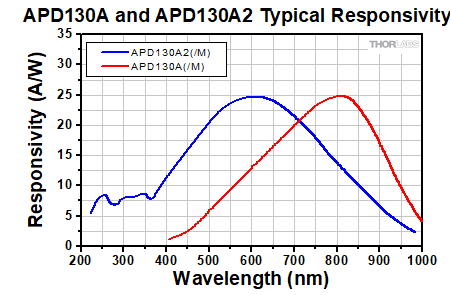
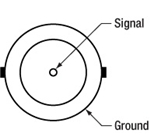

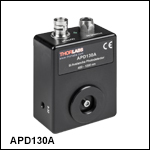
 ズーム
ズーム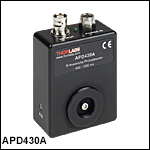
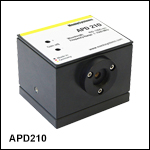
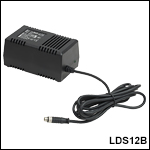










 Siアバランシェフォトディテクタ、自由空間型
Siアバランシェフォトディテクタ、自由空間型